Automotive Applications for Embedded Vision
Vision products in automotive applications can make us better and safer drivers
Vision products in automotive applications can serve to enhance the driving experience by making us better and safer drivers through both driver and road monitoring.
Driver monitoring applications use computer vision to ensure that driver remains alert and awake while operating the vehicle. These systems can monitor head movement and body language for indications that the driver is drowsy, thus posing a threat to others on the road. They can also monitor for driver distraction behaviors such as texting, eating, etc., responding with a friendly reminder that encourages the driver to focus on the road instead.
In addition to monitoring activities occurring inside the vehicle, exterior applications such as lane departure warning systems can use video with lane detection algorithms to recognize the lane markings and road edges and estimate the position of the car within the lane. The driver can then be warned in cases of unintentional lane departure. Solutions exist to read roadside warning signs and to alert the driver if they are not heeded, as well as for collision mitigation, blind spot detection, park and reverse assist, self-parking vehicles and event-data recording.
Eventually, this technology will to lead cars with self-driving capability; Google, for example, is already testing prototypes. However many automotive industry experts believe that the goal of vision in vehicles is not so much to eliminate the driving experience but to just to make it safer, at least in the near term.
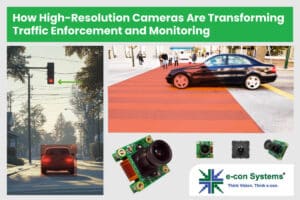
How High-resolution Cameras Are Transforming Traffic Enforcement and Monitoring
This blog post was originally published at e-con Systems’ website. It is reprinted here with the permission of e-con Systems. Smart traffic systems leverage embedded camera solutions to help manage roadways, record violations, and detect traffic anomalies. Get expert insights on how cameras work in these systems, their top use cases applications, and key imaging
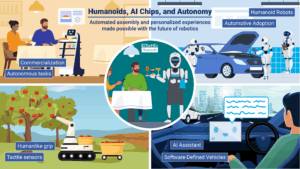
Humanoids, AI Chips, and Autonomy in the Future of Robotics
Humanoids, AI Chips, and Autonomy. Co-habiting or working alongside robots with humanlike capabilities may no longer be a thing of science-fiction. Assembling car parts or doing the weekly shop may be smart tasks for collaborative robots, while robotaxis boast the independence possible with the latest developments in vehicle autonomy. IDTechEx‘s research into Robotics & Autonomy

SiMa.ai Expands Strategic Collaboration with Synopsys to Accelerate Automotive AI Innovation
Transforming ADAS and In-Vehicle Infotainment Breakthroughs with Innovative ML IP, Chiplets, and System-on-Chip Reference Architectures SAN JOSE, Calif., July 30, 2025 /PRNewswire/ — SiMa.ai, a pioneer in ultra-efficient machine learning system-on-chip (MLSoC) platform, today announced the next phase of their strategic collaboration with Synopsys, the leading provider of engineering solutions from silicon to systems, to
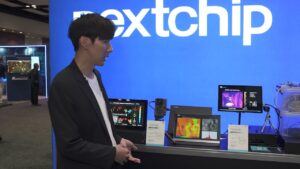
Nextchip Demonstration of Various Computing Applications Using the Company’s ADAS SoC
Jonathan Lee, Manager of the Global Strategy Team at Nextchip, demonstrates the company’s latest edge AI and vision technologies and products at the 2025 Embedded Vision Summit. Specifically, Lee demonstrates various computing applications using his company’s ADAS SoC. Lee showcases how Nextchip’s ADAS SoC can be used for applications such as: Sensor fusion of iToF
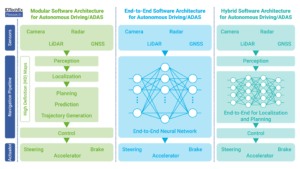
Is End-to-end the Endgame for Level 4 Autonomy?
Examples of modular, end-to-end, and hybrid software architectures deployed in autonomous vehicles. Autonomous vehicle technology has evolved significantly over the past year. The two market leaders, Waymo and Apollo Go, both have fleets of over 1,000 vehicles and operate in multiple cities, and a mix of large companies such as Nvidia and Aptiv, OEMs such

Software-defined Vehicles Drive Next-generation Auto Architectures
SDV Level Chart: Major OEMs compared. The automotive industry is undergoing a foundational shift toward Software-Defined Vehicles (SDVs), where vehicle functionality, user experience, and monetization opportunities are governed increasingly by software rather than hardware. This evolution, captured comprehensively in the latest IDTechEx report, “Software-Defined Vehicles, Connected Cars, and AI in Cars 2026-2036: Markets, Trends, and
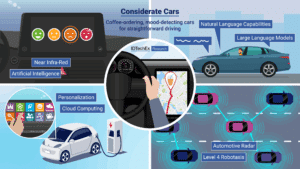
Considerate Cars: Making Calls for Coffee and Keeping Drivers Alert
Caffeine ready to collect as the car decides to pull over to charge could become the normality of the future, as software-defined vehicle technology and the presence of AI within vehicles advances. IDTechEx’s portfolios of Robotics & Autonomy and Semiconductors, Computing & AI research reports cover passenger safety and increased comfort, while the research onElectric

How Do Surround-view Cameras Improve Driving and Parking Safety?
This blog post was originally published at e-con Systems’ website. It is reprinted here with the permission of e-con Systems. As vehicles become more complex, their need for accurate imaging has increased. This has driven the adoption of surround-view cameras. They give drivers a complete, real-time, 360-degree view of the vehicle, thereby improving situational awareness

Synopsys Demonstration of Siengine’s AD1000 ADAS Chip, Powered by Synopsys NPX6 NPU IP
Gordon Cooper, Principal Product Manager at Synopsys, demonstrates the company’s latest edge AI and vision technologies and products at the 2025 Embedded Vision Summit. Specifically, Cooper demonstrates the powerful SiEngine AD1000 NPU and the robust toolchain including debugger, profiler, and simulator, which features Synopsys NPX6 NPU IP. Learn how the platform supports TensorFlow, ONNX, and
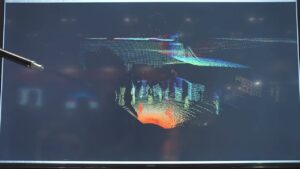
Namuga Vision Connectivity Demonstration of Compact Solid-state LiDAR for Automotive and Robotics Applications
Min Lee, Business Development Team Leader at Namuga Vision Connectivity, demonstrates the company’s latest edge AI and vision technologies and products at the 2025 Embedded Vision Summit. Specifically, Lee demonstrates a compact solid-state LiDAR solution tailored for automotive and robotics industries. This solid-state LiDAR features high precision, fast response time, and no moving parts—ideal for

